2019 HONDA CIVIC COUPE tow
[x] Cancel search: towPage 4 of 675
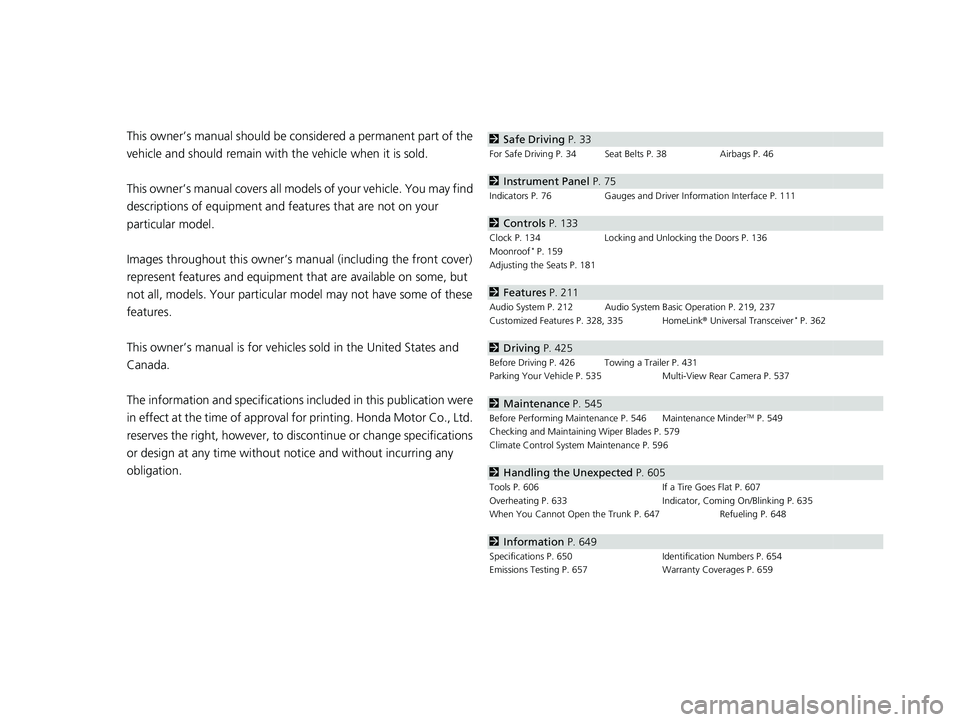
Contents
This owner’s manual should be considered a permanent part of the
vehicle and should remain with the vehicle when it is sold.
This owner’s manual covers all models of your vehicle. You may find
descriptions of equipment and features that are not on your
particular model.
Images throughout this owner’s manu al (including the front cover)
represent features and equipment that are available on some, but
not all, models. Your particular mo del may not have some of these
features.
This owner’s manual is for vehicles sold in the United States and
Canada.
The information and specifications in cluded in this publication were
in effect at the time of approval for printing. Honda Motor Co., Ltd.
reserves the right, however, to discontinue or change specifications
or design at any time without notice and without incurring any
obligation.2 Safe Driving P. 33
For Safe Driving P. 34 Seat Belts P. 38 Airbags P. 46
2Instrument Panel P. 75
Indicators P. 76 Gauges and Driver Information Interface P. 111
2Controls P. 133
Clock P. 134 Locking and Unlocking the Doors P. 136
Moonroof* P. 159
Adjusting the Seats P. 181
2 Features P. 211
Audio System P. 212 Audio System Basic Operation P. 219, 237
Customized Features P. 328, 335 HomeLink® Universal Transceiver* P. 362
2Driving P. 425
Before Driving P. 426 Towing a Trailer P. 431
Parking Your Vehicle P. 535 Multi-View Rear Camera P. 537
2Maintenance P. 545
Before Performing Maintenance P. 546 Maintenance MinderTM P. 549
Checking and Maintaining Wiper Blades P. 579
Climate Control System Maintenance P. 596
2Handling the Unexpected P. 605
Tools P. 606 If a Tire Goes Flat P. 607
Overheating P. 633 Indicator, Coming On/Blinking P. 635
When You Cannot Open the Trunk P. 647 Refueling P. 648
2Information P. 649
Specifications P. 650 Identification Numbers P. 654
Emissions Testing P. 657 Warranty Coverages P. 659
19 CIVIC 2D HCM (KA KL KC)-31TBG6300.book 2 ページ 2018年9月4日 火曜日 午後1時38分
Page 5 of 675
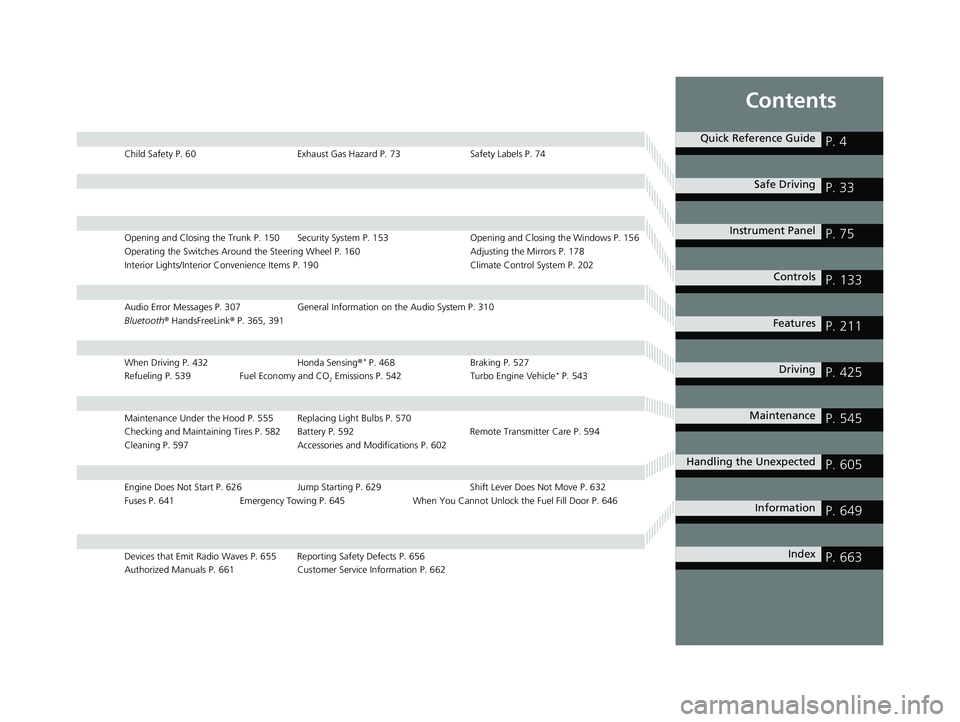
Contents
Child Safety P. 60Exhaust Gas Hazard P. 73Safety Labels P. 74
Opening and Closing the Trunk P. 150 Security System P. 153 Opening and Closing the Windows P. 156
Operating the Switches Around the Steering Wheel P. 160 Adjusting the Mirrors P. 178
Interior Lights/Interior Convenience It ems P. 190 Climate Control System P. 202
Audio Error Messages P. 307General Information on the Audio System P. 310
Bluetooth ® HandsFreeLink ® P. 365, 391
When Driving P. 432 Honda Sensing®* P. 468 Braking P. 527
Refueling P. 539 Fuel Economy and CO
2 Emissions P. 542 Turbo Engine Vehicle* P. 543
Maintenance Under the Hood P. 555 Replacing Light Bulbs P. 570
Checking and Maintaining Tires P. 582 Battery P. 592 Remote Transmitter Care P. 594
Cleaning P. 597 Accessories and Modifications P. 602
Engine Does Not Start P. 626 Jump Starting P. 629 Shift Lever Does Not Move P. 632
Fuses P. 641 Emergency Towing P. 645 When You Cannot Unlock the Fuel Fill Door P. 646
Devices that Emit Radio Waves P. 655 Reporting Safety Defects P. 656
Authorized Manuals P. 661 Customer Service Information P. 662
Quick Reference GuideP. 4
Safe DrivingP. 33
Instrument PanelP. 75
ControlsP. 133
FeaturesP. 211
DrivingP. 425
MaintenanceP. 545
Handling the UnexpectedP. 605
InformationP. 649
IndexP. 663
19 CIVIC 2D HCM (KA KL KC)-31TBG6300.book 3 ページ 2018年9月4日 火曜日 午後1時38分
Page 15 of 675
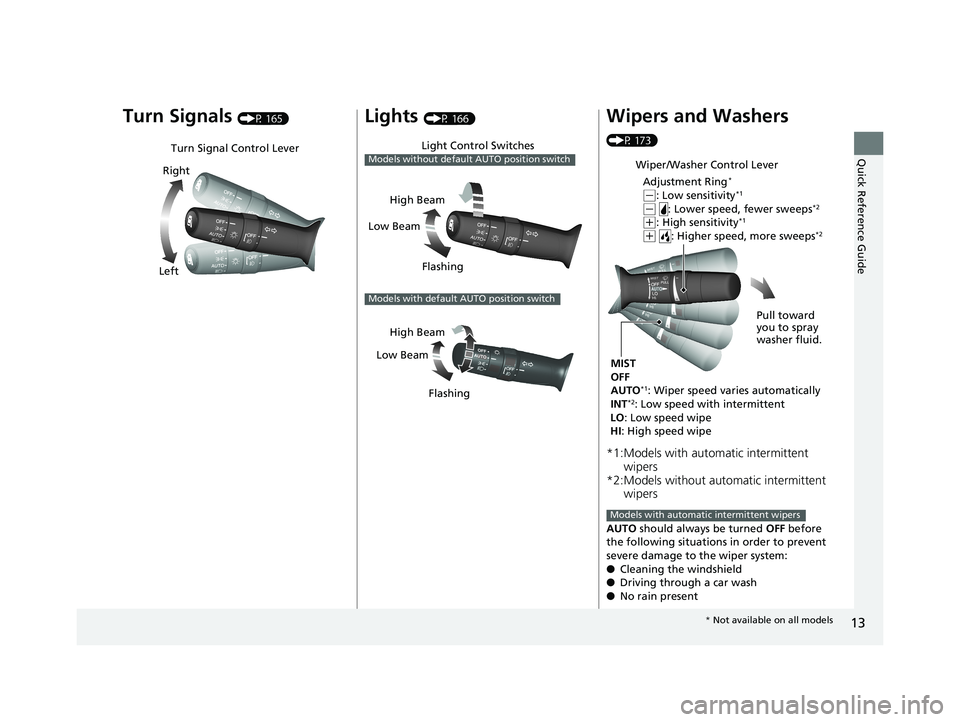
13
Quick Reference Guide
Turn Signals (P 165)
Turn Signal Control Lever
Right
Left
Lights (P 166)
Light Control Switches
Models without default AUTO position switch
Low Beam High Beam
Flashing
Models with default AUTO position switch
Low BeamHigh Beam
Flashing
Wipers and Washers
(P 173)
*1:Models with automatic intermittent wipers
*2:Models without automatic intermittent wipers
AUTO should always be turned OFF before
the following situations in order to prevent
severe damage to the wiper system:
● Cleaning the windshield
● Driving through a car wash
● No rain present
Wiper/Washer Control Lever
Adjustment Ring
*
(-: Low sensitivity*1
(- : Lower speed, fewer sweeps*2
(+: High sensitivity*1
(+ : Higher speed, more sweeps*2
MIST
OFF
AUTO
*1: Wiper speed varies automatically
INT*2: Low speed with intermittent
LO : Low speed wipe
HI : High speed wipe Pull toward
you to spray
washer fluid.
Models with automatic intermittent wipers
*
Not available on all models
19 CIVIC 2D HCM (KA KL KC)-31TBG6300.book 13 ページ 2018年9月4日 火曜 日 午後1時38分
Page 29 of 675
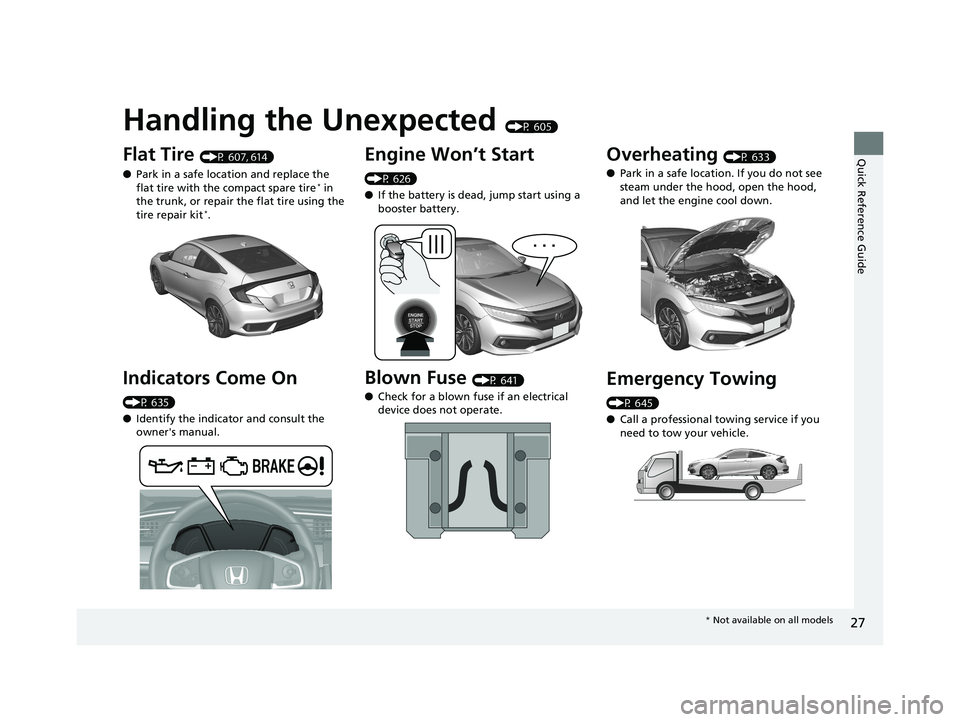
Quick Reference Guide
27
Handling the Unexpected (P 605)
Flat Tire (P 607, 614)
● Park in a safe location and replace the
flat tire with the compact spare tire
* in
the trunk, or repair the flat tire using the
tire repair kit
*.
Indicators Come On
(P 635)
● Identify the indica tor and consult the
owner's manual.
Engine Won’t Start
(P 626)
● If the battery is dead, jump start using a
booster battery.
Blown Fuse (P 641)
● Check for a blown fuse if an electrical
device does not operate.
Overheating (P 633)
● Park in a safe location. If you do not see
steam under the hood, open the hood,
and let the engine cool down.
Emergency Towing
(P 645)
●Call a professional towing service if you
need to tow your vehicle.
* Not available on all models
19 CIVIC 2D HCM (KA KL KC)-31TBG6300.book 27 ページ 2018年9月4日 火曜 日 午後1時38分
Page 45 of 675
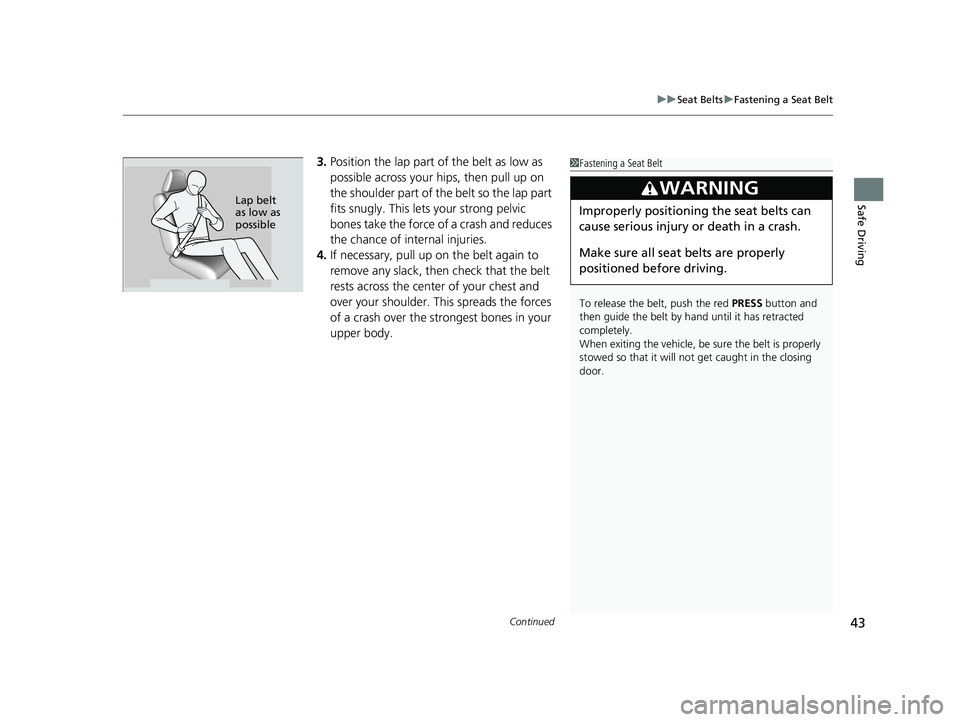
Continued43
uuSeat Belts uFastening a Seat Belt
Safe Driving
3. Position the lap part of the belt as low as
possible across your hips, then pull up on
the shoulder part of the belt so the lap part
fits snugly. This lets your strong pelvic
bones take the force of a crash and reduces
the chance of internal injuries.
4. If necessary, pull up on the belt again to
remove any slack, then check that the belt
rests across the center of your chest and
over your shoulder. Th is spreads the forces
of a crash over the strongest bones in your
upper body.1 Fastening a Seat Belt
To release the belt, push the red PRESS button and
then guide the belt by hand until it has retracted
completely.
When exiting the vehicle, be sure the belt is properly
stowed so that it will not get caught in the closing
door.
3WARNING
Improperly positioning the seat belts can
cause serious injury or death in a crash.
Make sure all seat belts are properly
positioned before driving.Lap belt
as low as
possible
19 CIVIC 2D HCM (KA KL KC)-31TBG6300.book 43 ページ 2018年9月4日 火曜 日 午後1時38分
Page 53 of 675

51
uuAirbags uFront Airbags (SRS)
Continued
Safe Driving
■When front airbags should not deploy
Minor frontal crashes: Front airbags were designed to supplement seat belts and
help to save lives, not to prevent minor scrapes, or even broken bones that might
occur during a less than mode rate-to-severe frontal crash.
Side impacts: Front airbags can provide protection when a sudden deceleration
causes a driver or front passenger to move towards the front of the vehicle. Side
airbags and side curtain airbags have been specifically designed to help to reduce
the severity of injuries that can occur du ring a moderate-to-severe side impact which
can cause the driver or passenger to move towards the side of the vehicle.
Rear impacts: Head restraints and seat belts are your best protection during a rear
impact. Front airbags cannot provide any significant protection and are not designed
to deploy in such collisions.
Rollovers: In a rollover, your best form of protection is a seat belt or, if your vehicle
is equipped with a rollover sensor, both a seat belt and a side curtain airbag. Front
airbags, however, are not designed to depl oy in a rollover as they would provide
little if any protection.
■When front airbags deploy with little or no visible damage
Because the airbag system senses sudden deceleration, a strong impact to the
vehicle framework or suspension might caus e one or more of the airbags to deploy.
Examples include running into a curb, the edge of a hole, or other low fixed object
that causes a sudden deceleration in th e vehicle chassis. Since the impact is
underneath the vehicle, damage may not be readily apparent.
■When front airbags may not deploy , even though exterior damage
appears severe
Since crushable body parts absorb crash energy during an impact, the amount of
visible damage does not always indicate proper airbag operation. In fact, some
collisions can result in severe damage but no airbag deployment because the airbags
would not have been needed or would not have provided protection even if they
had deployed.
19 CIVIC 2D HCM (KA KL KC)-31TBG6300.book 51 ページ 2018年9月4日 火曜 日 午後1時38分
Page 54 of 675

uuAirbags uFront Airbags (SRS)
52
Safe DrivingThe airbags have advanced features to help reduce the likelihood of airbag related
injuries to smaller occupants.
The driver’s advanced airbag system includes a
seat position sensor.
Based on information from this sensor and the
severity of the impact, the advanced airbag
system determines the optimal deployment of
the driver’s airbag.
The front passenger’s ad vanced airbag system
has weight sensors.
We advise against allowing a child age 12 or
under to ride in the front passenger’s seat.
However, if you do allow a child age 12 or
under to ride in the front passenger’s
seat, note that the system will automatically
turn off the front passenger’s airbag if the
sensors detect that the child is approximately
65 lbs (29 kg) or less.
■Advanced Airbags1 Advanced Airbags
If there is a problem with the driver’s seat position
sensor, the SRS indicator wi ll come on, and in the
event of a crash, the airbag will deploy (regardless of
the driver’s seating position) with a force
corresponding to the se verity of the impact.
For the advanced airbags to work properly:
•Do not spill any liquid on or under the seats.
•Do not put any object under the passenger’s seat.
•Make sure any objects are positioned properly on
the floor. Improperly pos itioned objects can
interfere with the advanced airbag sensors.
•All occupants should sit upri ght and wear their seat
belts properly.
•Do not cover the passenger ’s side dashboard with
a cloth, towel, cover, etc. 2Passenger Front Airbag Off Indicator
P. 58
Make sure the floor mat behind the front passenger’s
seat is hooked to the floor mat anchor. An improperly
placed mat can interfere with the advanced airbag
sensors. 2 Floor Mats P. 598
Driver’s
Seat
Position
Sensor
Passenger’s
Seat
Weight
Sensors
19 CIVIC 2D HCM (KA KL KC)-31TBG6300.book 52 ページ 2018年9月4日 火曜 日 午後1時38分
Page 56 of 675

54
uuAirbags uSide Airbags
Safe Driving
■When a side airbag deploys with little or no visible damage
Because the airbag system senses sudden acceleration, a strong impact to the side
of the vehicle’s framework can cause a side airbag to deploy. In such cases, there
may be little or no damage, but the side impact sensors detected a severe enough
impact to deploy the airbag.
■When a side airbag may not deploy, even though visible damage appears
severe
It is possible for a side airbag not to deploy during an impact that results in
apparently severe damage. This can occur when the point of impact was toward the
far front or rear of the vehicle, or when the vehicle’s crushable body parts absorbed
most of the crash energy. In either case , the side airbag would not have been
needed nor provided protection even if it had deployed.
19 CIVIC 2D HCM (KA KL KC)-31TBG6300.book 54 ページ 2018年9月4日 火曜 日 午後1時38分